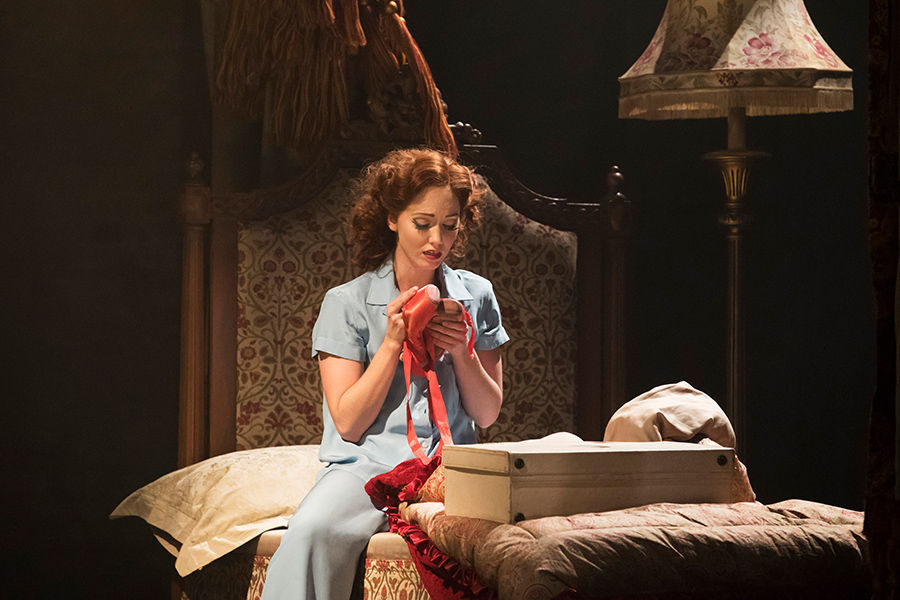As a child, Hans Christian Andersen (1805-1875) was poor and forced to work for a living as a tailor’s apprentice. He suffered a lifelong unrequited love for opera singer Jenny Lind. His “fairy tales” are full of orphaned and abandoned children, inanimate objects that suffer human emotions, and allegorical figures — the Ugly Duckling, the Little Mermaid — who speak to humanity’s profound existential loneliness.
“The Red Shoes” is one of Andersen’s more extreme stories. Karen, a girl whose mother has recently died, is taken under the care of a rich old woman with bad eyesight. Karen covets a pair of red patent leather shoes, finagles the old lady into buying them and, without her benefactor’s knowledge, wears them to her confirmation, then to her First Communion.
“When Karen knelt at the altar rails the chalice was put to her lips, she thought only of the red shoes. She seemed to see them floating before her eyes. She forgot to join in the hymn of praise and she forgot to say the Lord’s Prayer.”
Well! Nothing good can come of that.
The shoes, when worn, cast an evil spell. Karen dances in them, elated at first and then horrified to find that they are stuck fast to her feet. She is sentenced to dance ceaselessly, eternally. “So off she danced, and off she had to dance, over fields and meadows, in rain and sunshine, by day and by night, but at night it was fearful.”
In desperation, she approaches the village executioner.
“Don’t chop my head off,” she pleads, “for then I can never repent of my sins. But pray, pray chop off my feet with the red shoes.” The shoes with the severed feet in them dance away into the forest. “Then [the executioner] made her a pair of wooden feet and crutches, and he taught her a psalm, the one penitents always sing.” Karen ends up back at church, her heart purified. While sitting on her little bench there, she dies and goes to heaven.
That’ll teach us to think vain thoughts during Mass!
Many may be more familiar with Michael Powell and Emeric Pressburger’s iconic 1948 film version of “The Red Shoes.” Here Karen, played by prima ballerina Moira Shearer, becomes Victoria Page (“Vicky”), a passionate young ballerina ruthlessly pressured by dance impresario Lermontov to choose stardom over love. Shot in thrillingly lurid Technicolor, the film is part camp hoot, part classic romantic tragedy. Vicky’s lips shine like slices of poisoned apple and the ravishingly red pointe shoes seem to pulsate with sinister allure. Like any of us would, Vicky yields to the temptation to become famous, ditches her beloved husband, dons the shoes and dances herself into death.
Well, maybe not all of us. But anyone who has been set on fire by art is familiar with the temptation to make the desire for immortality into a god. Every artist knows the danger of being consumed by the creative urge. Every artist has skated the razor’s edge between passion and pathology.
English choreographer Matthew Bourne saw the film version of “The Red Shoes” as a teenager. He’d never before seen a ballet live on stage. The experience electrified him.
“The film’s genius is to make that theatrical world at times surreal, larger than life and highly cinematic. My challenge was to capture some of that surreal, sensuous quality within the more natural theater setting.”
Bourne (b. 1960) danced professionally himself for 14 years, then formed his first company, embarking on what has become an illustrious, award-winning career in contemporary dance and theater.
He has choreographed groundbreaking versions of classic ballets: “Nutcracker,” “Swan Lake” and “Sleeping Beauty.” His 2005 production of “Edward Scissorhands,” based on the Tim Burton movie, broke box-office records at London’s Sadler’s Wells Theater.
Launched in 2002, his current company is called New Adventures. “The Red Shoes,” his 11th full-length production, premiered in 2016, also in London. Based on the Powell and Pressburger film, the ballet will be presented this fall by Center Theatre Group and Glorya Kaufman Presents Dance at The Music Center. The production runs Sept. 15 through Oct. 1 at downtown L.A.’s Ahmanson Theater.
This American premiere will feature a new score arranged by Terry Davies using the music of Bernard Herrmann — that’s right, the prolific Hollywood golden-age composer perhaps best known for the shower scene in Hitchcock’s “Psycho.”
In addition to the potential conflict between love and art, the ballet’s themes include career versus love, the blurring of the boundaries between dramatic literary characters and real people, and obsession.
For his part, Bourne considers “The Red Shoes” his “love letter to the world of theater.”
For my own, I’m with Hans Christian Andersen’s Karen, who — back in church with her wooden feet — could still say, “It was God’s mercy!”
“Her heart was so overfilled with the sunshine, with peace and with joy, that it broke her soul, flew with the sunshine to heaven, and no one there asked about the red shoes.”
Heather King is a blogger, speaker and the author of several books.

